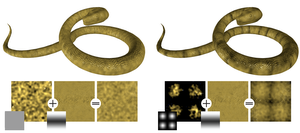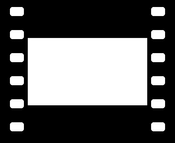Information
- Publication Type: Conference Paper
- Workgroup(s)/Project(s):
- Date: May 2014
- ISBN: 978-80-223-3601-7
- Publisher: ACM Press
- Location: Smolenice castle, Slovakia
- Lecturer: Victor Charpenay
- Editor: Diego Gutierrez
- Booktitle: Proceedings of the 30th Spring Conference on Computer Graphics - SCCG
- Conference date: 28. May 2014 – 30. May 2014
- Pages: 79 – 82
- Keywords: texture synthesis, Gabor noise, procedural texture
Abstract
Gabor noise is a powerful technique for procedural texture generation. Contrary to other types of procedural noise, its sparse convolution aspect makes it easily controllable locally. In this paper, we demonstrate this property by explicitly introducing spatial variations. We do so by linking the sparse convolution process to the parametrization of the underlying surface. Using this approach, it is possible to provide control maps for the parameters in a natural and convenient way. In order to derive intuitive control of the resulting textures, we accomplish a small study of the influence of the parameters of the Gabor kernel with respect to the outcome and we introduce a solution where we bind values such as the frequency or the orientation of the Gabor kernel to a user-provided control map in order to produce novel visual effects.Additional Files and Images
Weblinks
No further information available.BibTeX
@inproceedings{charpenay-2014-sgn,
title = "Sampling Gabor Noise in the Spatial Domain",
author = "Victor Charpenay and Bernhard Steiner and Przemyslaw
Musialski",
year = "2014",
abstract = "Gabor noise is a powerful technique for procedural texture
generation. Contrary to other types of procedural noise, its
sparse convolution aspect makes it easily controllable
locally. In this paper, we demonstrate this property by
explicitly introducing spatial variations. We do so by
linking the sparse convolution process to the
parametrization of the underlying surface. Using this
approach, it is possible to provide control maps for the
parameters in a natural and convenient way. In order to
derive intuitive control of the resulting textures, we
accomplish a small study of the influence of the parameters
of the Gabor kernel with respect to the outcome and we
introduce a solution where we bind values such as the
frequency or the orientation of the Gabor kernel to a
user-provided control map in order to produce novel visual
effects.",
month = may,
isbn = "978-80-223-3601-7",
publisher = "ACM Press",
location = "Smolenice castle, Slovakia",
editor = "Diego Gutierrez",
booktitle = "Proceedings of the 30th Spring Conference on Computer
Graphics - SCCG ",
pages = "79--82",
keywords = "texture synthesis, Gabor noise, procedural texture",
URL = "https://www.cg.tuwien.ac.at/research/publications/2014/charpenay-2014-sgn/",
}



